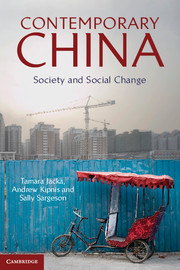Book contents
- Frontmatter
- Contents
- List of Images
- List of Maps
- List of Figures
- List of Tables
- Acknowledgments
- List of Abbreviations
- Map 0.1: China's provinces and provincial capitals
- Introduction
- Part 1 Social Institutions
- Part 2 Cultures, Socialization and the Formation of Identities
- Part 3 Inequalities, Injustices and Social Responses
- 10 Social Class and Stratification
- 11 Regional, Rural–Urban and Within-community Inequalities
- 12 The “Woman Question” and Gender Inequalities
- 13 Collective Action and Social Change
- Glossary of Chinese Terms
- References
- Index
12 - The “Woman Question” and Gender Inequalities
Published online by Cambridge University Press: 05 June 2014
- Frontmatter
- Contents
- List of Images
- List of Maps
- List of Figures
- List of Tables
- Acknowledgments
- List of Abbreviations
- Map 0.1: China's provinces and provincial capitals
- Introduction
- Part 1 Social Institutions
- Part 2 Cultures, Socialization and the Formation of Identities
- Part 3 Inequalities, Injustices and Social Responses
- 10 Social Class and Stratification
- 11 Regional, Rural–Urban and Within-community Inequalities
- 12 The “Woman Question” and Gender Inequalities
- 13 Collective Action and Social Change
- Glossary of Chinese Terms
- References
- Index
Summary
In the late 19th and early 20th centuries, debates over what was often referred to as the “woman question” preoccupied the educated social elite in China, just as it did in Europe, Britain and the United States. Leading Chinese intellectuals and political activists viewed patriarchal norms that subordinated women as the epitome of the “backwardness” and degeneration of Confucian social institutions. These (mainly male) reformers and revolutionaries saw women – uneducated, hobbled by foot-binding and subordinated by the “three obediences” (to their father, husband and sons) – both as a metaphor for the weakness of China and the Chinese state, and as literally holding the country back from becoming modern and strong on the world stage. Women were supposedly unproductive, unable to participate in public affairs and poorly equipped to raise their children into modern citizens. Like modernizing elites elsewhere across the world, the reformers viewed the liberation of women and the achievement of gender equality as necessary for national strength and self-determination, modernity and social progress.
In the first half of this chapter, we discuss the lasting impact that the woman question has had in the 20th and 21st centuries on Chinese state policies regarding gender inequalities, and we assess the social consequences of those policies. We also look at the ways in which scholars have approached the topic of gender inequality in China. In the second half, we examine some of the main institutions through which gender inequalities continue to be reproduced today, despite decades of state policies and legislation aimed at overcoming them.
- Type
- Chapter
- Information
- Contemporary ChinaSociety and Social Change, pp. 237 - 256Publisher: Cambridge University PressPrint publication year: 2013

